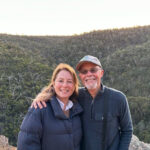Farmers placed clumps of soil into metal mesh baskets, submerged the baskets into jars of water, then watched to see if their soil held together. The slake test, conducted at the Soil Health Field Day in Woodland, measured soil health. Healthier soil, which contains more organic matter and bioactivity and can better support plant growth, stays intact.
“Participants said that it was particularly useful to see the slake test on a variety of soils to better understand the nuance of how soil health management practices such as cover cropping and reduction of tillage intensity could affect soil aggregation,” said Sonja Brodt, UC Sustainable Agriculture Research and Education Program coordinator for agriculture and environment, who attended the field day alongside Vivian Wauters, SAREP project scientist.
Technical assistance providers, farmers and other soil health professionals gathered at the Center for Land-Based Learning on Nov. 19 to learn about preparing soil for winter with a specific focus on how soil health impacts soil structure, as well as the ability for water to move through soil as opposed to puddling or running off a field.
“Soil with stable aggregates can withstand this submersion and stay intact, whereas a soil with poor aggregation will fall apart in the water,” Wauters explained.
This in-field test can produce dramatically different results, where poorly aggregated soil colors the water, while the stable, aggregated soil will leave the water column relatively clear.
Farmers were invited to bring their own soil samples to perform slake tests at the field day. Kabir Zahangir, USDA Natural Resources Conservation Service regional soil health specialist, compared soils from different management practices and discussed how to assess aggregate stability and soil water infiltration.
LIndsey Kelley discussed regional benchmarks for soil health.
Margaret Lloyd, UC Cooperative Extension small farms advisor for the Capitol Corridor, and Lindsey Kelley, UCCE small farms community education specialist, discussed regional benchmarks for soil health.
Attendees also heard from experienced growers Scott Park of Park Farming Organics and Andrew Brait of Full Belly Farm, who described how they assess soil health on their farms.
By collaborating with others, Brodt said farmers and researchers are achieving benefits through learning together in real time. “We will also be able to benefit from aggregating soils data from across regions to begin to develop a statewide soil health database, which is a critical step in order for researchers to be able to determine relationships between farming practices and soil health outcomes under California conditions in the future,” she said.
Slake tests can be performed on soil from one’s own backyard, garden or farm to better understand the health of the soil. Additionally, the NRCS principles of soil health – minimized disturbance, maximized biodiversity, maximized soil cover and maximized living roots – can be applied across all scales, though the specific practices will vary based on the type of yard or farm as well as the local climate and soil type.
Brodt and Wauters, who coordinate the California Farm Demonstration Network, emphasize that it’s important to have local examples of innovative conservation practices across the state so people can see what is working to protect and enhance the soil health in their specific region. They encourage farmers and technical assistance providers to visit https://www.calfarmdemo.org/ to find local farms that are showcasing innovative practices. Farmers interested in being a farm demonstration site are also encouraged to contact Brodt (sbbrodt@ucanr.edu) and Wauters (vwauters@ucanr.edu).
They hope to continue to support the learning and sharing of knowledge around climate-smart farming practices to help California’s farmers adopt climate beneficial practices.
“CDFA has funding programs, such as their Healthy Soils grants, that farmers in our network can apply for to help cover the costs of implementing soil health practices,” Brodt said.
Current work on the California Farm Demonstration Network is funded through a University of California Office of the President Climate Action Grant.




GIPHY App Key not set. Please check settings